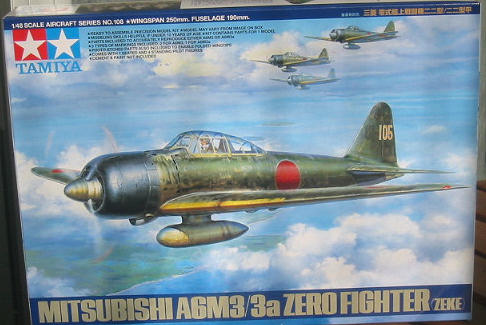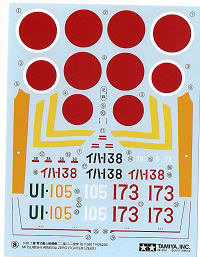
| KIT #: | 61108 |
| PRICE: | AUD $49.95 |
| DECALS: | Three Options |
| REVIEWER: | Bob Kudyba |
| NOTES: | Recently released injection moulded kit |

| HISTORY |
The opening of the Pacific war saw the introduction into theatre of the Japanese
A6M2 Zero fighter Model 21, which was acknowledged as the best in-theatre
fighter at the time. However rapid advances by the Allies in aircraft design and
production soon challenged the Zero’s supremacy.
The Japanese were quick to realise that these early models of the Zero were no
longer able to maintain an ‘edge’ in combat with the increasing number of new
fighters being produced and fielded by the Allies. Deployed in early 1943, the
A6M3 Model 22 Zero was a quick response to the shortcomings of the earlier A6M3
Model 32. Due to using the improved Sakae 21 engine, the fuel tank capacity of
the Model 32 was reduced from 98 litres to 60, because of less available space
in the fuselage and the inclusion of a supercharger caused the engine to consume
more fuel. These design features resulted in a reduction in the range of the
Model 32 Zero.
The vast distances of the Pacific also forced the Japanese to use air bases set
back from the front line. The Japanese deployed the Model 32 Zero to the
Famed Japanese ace, Saburo Sakai mentions in his book[1]
the need to fly long distances to undertake escort missions for Japanese
bombers, raiding the Solomon’s and then being confronted with a long trip home;
requiring the need to conserve fuel. After mistaking a flight of US Navy Avenger[2]
aircraft for fighters, he was injured in the attack and forced to fly over 500
nautical miles back to his base; flying a damaged aircraft and also travelling
through a tropical thunderstorm and suffering wounds that included the loss of
sight in one eye.
The A6M3/3a versions of the Zero Model 22 were developed to rectify the
short-comings in the earlier Model 32. By returning to the folding tip
extensions on the wings and increased fuel tank capacity, the improved Model 22
had better manoeuvrability and also the range of the aircraft was extended by
1,000 km. The 3a version of the Model 22 featured long-barrelled 20mm Type 99-2
Model 3 cannons. The A6M3 Model 22 featured two flush mounted cannons in the
wings.
Unfortunately for the Japanese, the introduction of
Allied fighters such as: P-38 Lightning and F4U Corsair, together with
the Supermarine Spitfire, into the Pacific theatre at that stage saw many A6M3
Model 22 fall prey to these vastly improved fighter aircraft.
A great deal has been written on the Japanese Zero, its development and subsequent versions and this information can be viewed in other previews on line here.
| THE KIT |
 The
Japanese Zero has been a favourite modelling subject of many manufacturers over
the years; I remember completing my first 1/48th kit of the Zero back
in the early 1970’s; the kit featured a retractable undercarriage with a pilot
‘figure’ that was cemented to one half of the fuselage. With the undercart down,
you could look right through the canopy and see down through the wheel well
openings, where the undercarriage legs retracted into.
The
Japanese Zero has been a favourite modelling subject of many manufacturers over
the years; I remember completing my first 1/48th kit of the Zero back
in the early 1970’s; the kit featured a retractable undercarriage with a pilot
‘figure’ that was cemented to one half of the fuselage. With the undercart down,
you could look right through the canopy and see down through the wheel well
openings, where the undercarriage legs retracted into.
Tamiya and Hasegawa have been closely rivalling each other with releases of Zero
kits in 1/48th over the years and with Hasegawa’s recent release(s)
of every Zero model, from the A6M1 through to the A6M8, it was only a matter of
time before Tamiya responded with some new kits of this aircraft. Tamiya (
This kit represents the A6M3/3a Model 22 version that was released after the
Model 32 Zero, which was noted for the ‘clipped’ wings. The Model 22 Zero
returned to the rounded wing tips, which again, could be folded, like the
earlier Model 21. This feature is in the kit and highlighted by the use of
photo-etched parts that allow the model to be displayed with wing tips folded or
extended.
The instructions explain each step of assembly, beginning with the construction
of the cockpit area. The wealth of cockpit detail on this model is acknowledged
with a number of very intricate parts for various controls and rudder pedals,
together with an abundant instrument panel. Both sides of the fuselage contain
the various control levers and instrument boxes of the real Zero. A decal is
also provided for the seatbelts.
The construction of the engine and cowl assemblies, which are straightforward,
follows. The next steps are the constructions of the wings and Tamiya have
provided separate enclosures for the undercarriage wheel wells. At this stage
the modeller needs to decide upon displaying the model with wingtips either
‘folded’ or extended. A series of clearly marked photo-etched parts are supplied
separately for this step. The next assembly consists of the rudder and inclusion
of the flap systems. These can be displayed lowered, or raised.
Final assemblies see attaching the undercarriage and propeller, together with
the drop tank and canopy. As the modeller arrives at Step 18, they are required
to decide on either the A6M3 version, with the fully enclosed cannons in each
wing, or the long-barrelled 3a model. Look closely for the ‘A’, ‘B’ or ‘C’
indicators here to select the correct parts! The drop tank is attached by a poly
plug mount contained within the bottom part of the wings and can be removed, if
desired. Tamiya supply a canopy mask to assist in the delicate task of painting
canopy frames. Five pilot figures are included with the kit; one seated and four
in various standing poses. The seated figure is included with the ‘A’ sprue
parts; the additional four standing figures are included as a separate sprue
‘Z’. Six grey plastic sprues are included, together with one clear sprue (‘F’).
Detail on the kit is excellent with a number of small parts captured well. While
the parts are flash-free, there is some evidence of mould seams, especially on
the additional pilot figures. Each sub-assembly is packed in a separate plastic
bag; there are seven separate sprues in total, including the clear canopy.
Sprues ‘A’ and ‘B’ are included together. Decals
are supplied for three different aircraft and consist of two separate sheets,
one for the three aircraft described below and the second, smaller sheet for
various details on the plane:
 a.
251st Naval Air Group in the Solomon’s, May 1943-this aircraft has an
overall grey-green fuselage with green mottling on the upper surfaces and a
black cowl (A6M3 Model 22).
a.
251st Naval Air Group in the Solomon’s, May 1943-this aircraft has an
overall grey-green fuselage with green mottling on the upper surfaces and a
black cowl (A6M3 Model 22).
b.
Iwakuni Naval Air Group, Iwakuni Airbase, Yamaguchi Prefecture, Autumn 1943-this
aircraft is presented in an overall grey-green scheme with black cowl (A6M3
Model 22).
c.
Plane of Major Saburo Shindo, 582nd Naval Air Group, Buin,
Bougainville, June 1943-this aircraft is presented in the traditional IJNAF
Green upper, with grey-green lower surfaces and black cowl (A6M3a Model 22).
The painting guide is a separate A3 sized sheet, depicting the paint schemes and
decal placement; however this sheet is in black and white. The instructions are
the usual Tamiya instruction booklet written in English, German, French and
Japanese. A separate sheet discusses the variants of the Zero fighter, again, in
the four languages and displays various recognition features that highlighted
the Model 21, 32, 22 and 52 Zero fighters.
| CONCLUSIONS |
Tamiya have produced a very good model of the A6M3/3a Zero in the popular 1/48th
scale. I have not had the chance to compare the Tamiya kit with the Hasegawa
example, so I cannot make informed judgements on which is the better model kit,
however this recent release by Tamiya is well presented, with a good range of
options for the modeller to undertake.
| REFERENCES |
‘Samurai!’
by Saburo Sakai with Martin Caidin and Fred Saito-various hardcover and
paperback versions of this book are in print, which was first published in
English in 1957-see www.amazon.com
‘Japanese Aircraft of the Pacific War’
by Rene J. Francillon (1970) Putnam ISBN 0 85177 801 1
Samson Low Guides-‘World Aircraft-World
War II Part II’ (1978) SBN 562 00096 8
[1]
Samurai! by Saburo Sakai with Martin Caidin and Fred Saito, Naval
Institute Press (2010) is one example; this book was first published in
English in 1957. Various hardcover and paperback versions are available
from www.amazon.com
[2]
Note, some sources mention this encounter was with SBD Dauntless
aircraft; at the time
August 2010
If you would like your product reviewed fairly and quickly, please contact me or see other details in the Note to Contributors.